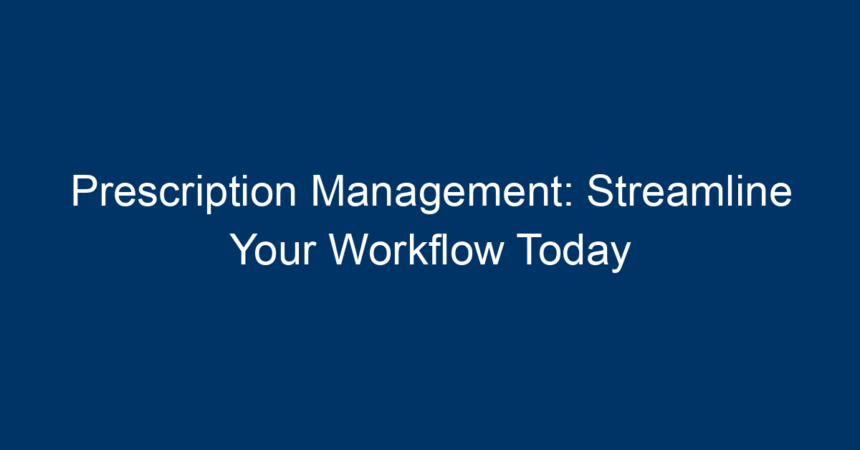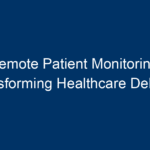In today’s fast-paced healthcare environment, effective prescription management is essential for ensuring patient safety, enhancing operational efficiency, and boosting overall productivity. From electronic health records to automated refill requests, the tools available to healthcare professionals continue to evolve. This article explores how to streamline your prescription management process, ultimately improving the workflow for both medical staff and patients.
What is Prescription Management?
Prescription management refers to the systematic process of administering, tracking, and optimizing the prescribing of medications to patients. This process includes the use of electronic prescriptions, monitoring patient adherence, managing formulary guidelines, and improving communication between healthcare providers and patients. The ultimate goal is to provide the best possible care while minimizing errors and simplifying the administrative load on healthcare staff.
Why Effective Prescription Management is Vital
-
Patient Safety
Managing prescriptions effectively helps prevent medication errors, such as incorrect dosages or drug interactions. By implementing an efficient system, healthcare providers can ensure that patients receive the correct medications at the right times. -
Operational Efficiency
A streamlined prescription workflow reduces the administrative burden on staff, allowing them to focus more on patient care rather than paperwork. This efficiency leads to shorter wait times and improved patient satisfaction. -
Increased Compliance
When patients understand their prescriptions and can easily access their medications, compliance with medication regimens increases. This is critical for managing chronic conditions and improving health outcomes. - Cost-Effectiveness
Poor prescription management can lead to wasteful spending on unnecessary medications. Efficient management helps in choosing the right treatments, ultimately saving costs for both patients and healthcare facilities.
Key Components of an Effective Prescription Management System
1. Electronic Prescription Systems (e-Prescribing)
E-prescribing is a digital way of handling prescriptions, eliminating paper-based processes. This technology enables physicians to send prescriptions directly to pharmacies, minimizing the chances for errors while streamlining the entire workflow.
Benefits:
- Reduces handwriting errors
- Enables real-time access to patient medication history
- Supports formulary checking to ensure prescribed medications are covered by insurance
2. Medication Reconciliation
Medication reconciliation is the process of ensuring that a patient’s medication lists are accurate across all transitions of care. This is especially important during hospital admissions, discharges, or transfers.
Benefits:
- Prevents adverse drug interactions
- Ensures continuity of care
- Provides an opportunity for patient education about their medications
3. Patient Education and Engagement
Engaging patients in their prescription management process can significantly improve adherence rates. Providing clear information about medications, including side effects and proper usage, empowers patients to take charge of their health.
Benefits:
- Enhances understanding of treatment plans
- Encourages open communication with healthcare providers
- Increases patient satisfaction
4. Automated Refill Management
Implementing an automated refill system can greatly reduce the hassle of prescription renewals. This technology manages refill requests and notifications, reminding patients when to get their medications refilled.
Benefits:
- Reduces pharmacy calls and administrative workload
- Improves medication adherence
- Increases patient convenience
5. Data Analytics
Using data analytics in prescription management allows healthcare facilities to monitor prescription patterns and outcomes. By analyzing this data, providers can identify trends, optimize formularies, and enhance decision-making processes.
Benefits:
- Personalized medication approaches for patients
- Improved compliance tracking
- Enhanced quality of care
Streamlining Your Prescription Management Workflow
Now that we understand the components of effective prescription management, it’s time to delve into actionable steps to optimize your workflow:
Step 1: Evaluate Current Processes
Assess your current prescription management workflow for bottlenecks or inefficiencies. Are manual processes slowing down your operations? Identifying these pain points is the first step in streamlining your systems.
Step 2: Invest in Technology
Consider adopting e-prescribing and automated refill management systems. Evaluate different software solutions that include features such as medication reconciliation, patient portals, and data analytics to enhance your practice’s capabilities.
Step 3: Engage Patients Actively
Incorporate strategies to engage patients in their medication management process. This could include routine check-ups, distributing easy-to-understand medication guides, or setting up telehealth consultations to review prescriptions.
Step 4: Train Staff Effectively
Educate your staff about the new prescription management tools and processes. A well-trained team can utilize technology efficiently and serve as a valuable resource for patients needing assistance with their prescriptions.
Step 5: Monitor and Adapt
Regularly review the outcomes of your prescription management practices. Collect feedback from both staff and patients to identify areas for improvement. Don’t be afraid to adapt your strategies based on real-world experiences.
Conclusion: The Future of Prescription Management
Effective prescription management not only enhances patient safety and satisfaction but also streamlines workflows, making healthcare more efficient. By embracing technology, actively engaging patients, and continually assessing your practices, you can create a more effective environment for medication management.
As the healthcare landscape evolves, the need for efficient prescription management will only grow. By taking actionable steps today, you can streamline your workflow, reduce errors, and ultimately improve patient outcomes. Take the leap into the future of medication management—your patients, staff, and practice will thank you.
Actionable Insights
- Conduct regular audits of your prescription management practices.
- Implement e-prescribing solutions if you haven’t already.
- Foster a culture of communication and education around medications.
- Don’t hesitate to experiment with new technologies and methods.
By focusing on these strategies, you can significantly enhance your prescription management and the overall quality of care in your practice. Start today and see the difference in your workflow!




